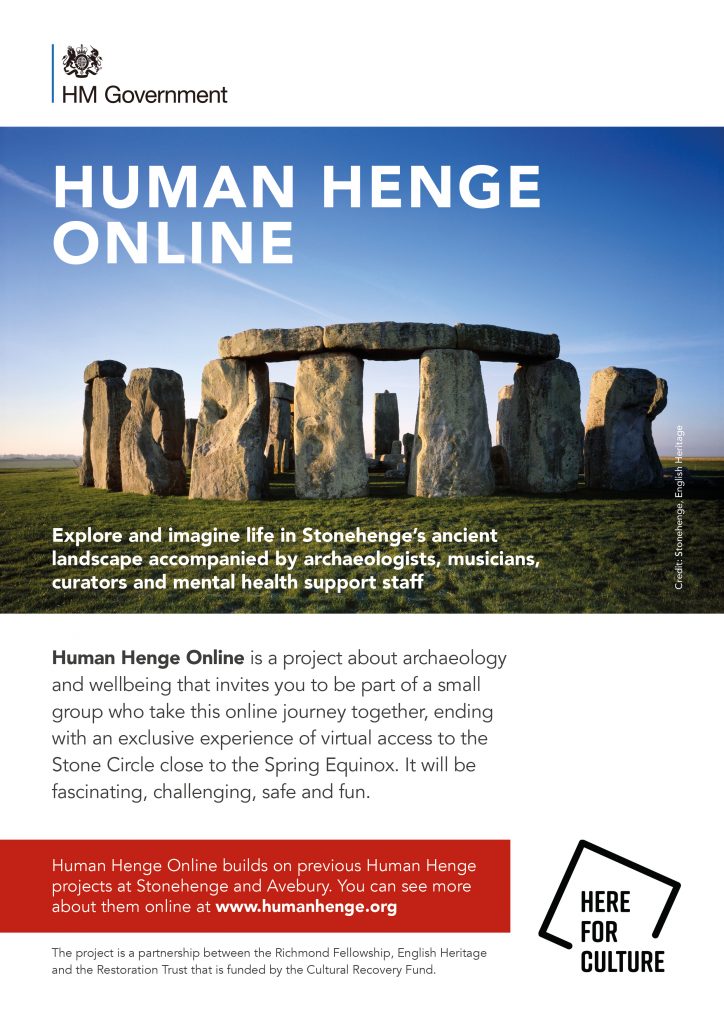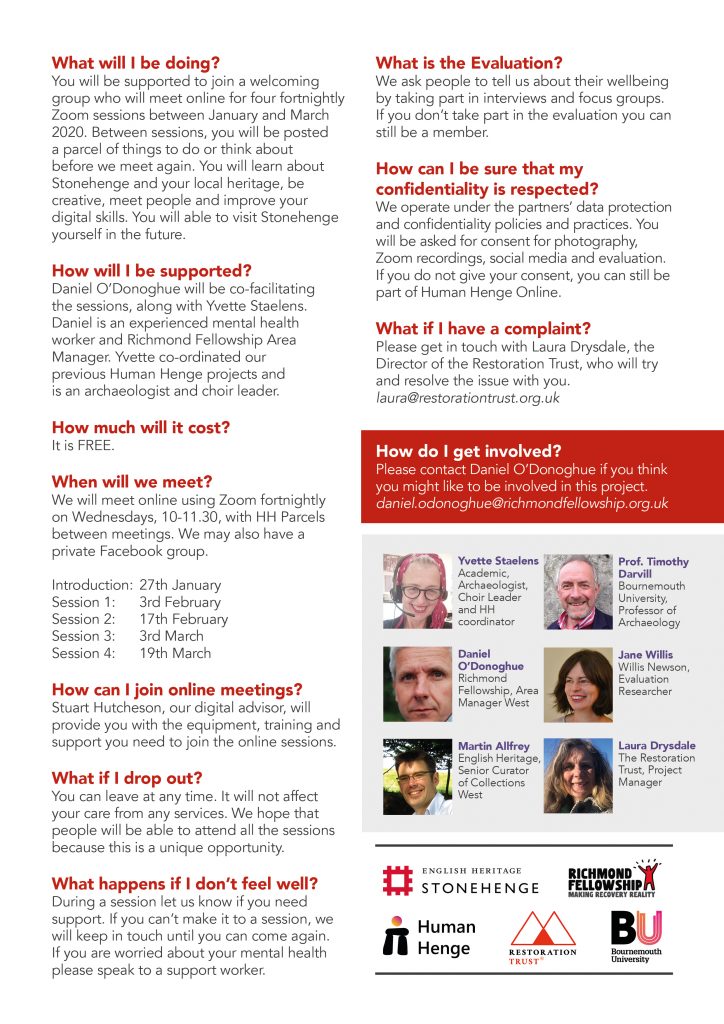Author Archives: hhmaster
Human Henge features in Guardian article about heritage and mental health
Heritage healing: why historic houses improve wellbeing
Staying in a landmark building has been found to counteract stress and anxiety
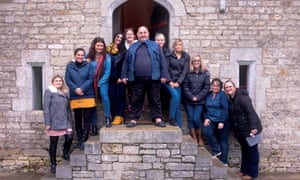
With its low gables and sunny verandahs, the empty former cottage hospital of Winsford is a building like no other in the world. The result of a philanthropic dream shared by a rich widow and a leading Victorian architect, in the 119 years since the ailing people of north Devon were first welcomed under its slate roof, the place has aided many a recovery, including shell-shocked soldiers seeking sanctuary from first world war trenches.
And soon Winsford, at Halwill Junction near Beaworthy, will be helping people again. The disused hospital, designed by Charles Voysey as a gift from the wealthy Maria Medley to the surrounding rural communities between Dartmoor and the coast, and now being restored by the Landmark Trust, is the latest example of a growing faith in the healing powers of heritage buildings. For in the same way that walks through Britain’s forests are now being prescribed as an effective way to help counteract anxiety and stress, so the conservation trusts and charities of the heritage industry are starting to promote the power of ruins and historic buildings to improve mental wellbeing.
“It is a common theme we get back from all our stayers,” said historian Caroline Standford, of Landmark, a charity that rescues, restores and then rents out significant historic buildings. “So many say how much calmer they feel. It is so appropriate that we can use Winsford next year, because it is a place that has such a strong sense of nurturing about it.
“It is so much more welcoming than what we think of as a medical centre today. Before Voysey built it, his only cottage hospital, the villagers in the 13 surrounding rural parishes who fell ill had to travel all the way to Exeter or Okehampton.”
From next year, not only will a third of the old hospital be restored for continued use as a community health resource, but each year the remainder will be offered out at no cost for selected dates, along with some of the trust’s other buildings, as a place for those in need, including bereaved children, traumatised veterans and carers, to come and recuperate.
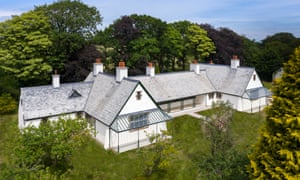
The scheme, called 50 for Free, has been running for five years and was inspired by the way that visitors to the trust’s buildings commented on how their mood was boosted by a stay in an ancient place, or unusual historic venue, away from the trappings of modern life. Applications for the next charitable visits open next month.
English Heritage and Historic England, two of Britain’s other major heritage and conservation charities, are also exploring the therapeutic side of their properties. English Heritage has set up days for people living with mental health problems and on low incomes at Stonehenge, a site it maintains jointly with the National Trust. Human Henge events focus on the site’s strong associations with natural healing and contemplation, much as the Japanese therapy of shinrin-yoku, or forest bathing, is now being prescribed by some doctors treating depression.
Historic England has also found that visits to historic towns, ancient places of worship and archaeological sites have the same beneficial effects on blood pressure and general wellbeing as social sporting activity.
Research by University College London five years ago was among the first to make the link between heritage sites and mental wellness. It showed that contact with a heritage site, whether as a visitor or a volunteer, frequently improved mood and even promoted a sense of citizenship among isolated and disadvantaged groups.
And this weekend, at the culmination of the annual Heritage Open Days week, many of Britain’s local authorities will be encouraging families to visit nearby museums, stately homes and historic sites as a healthy way to break the repetitive pattern of work, shopping and domestic chores.
While a period of respite in a beautiful castle or folly would probably benefit anyone, Stanford believes that Winsford, offering a moment “out of time”, with no phone or television, was always destined to be a haven of peace and healing again. Now, as the last nails are hammered in by conservationists, it is a place of restoration in both senses of the word.
Spring Equinox gathering at Stonehenge 22 March 2019
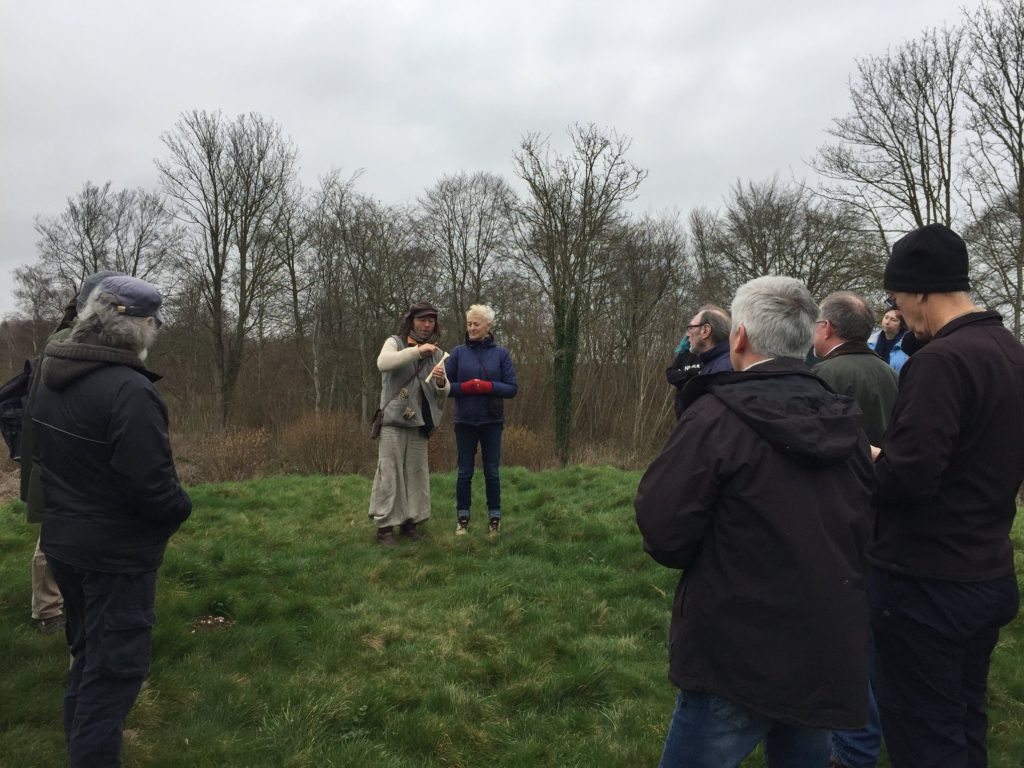
We held another post-project gathering at Stonehenge just after the Spring Equinox. Around 25 people came along. A walk to the Monarch of the Plain led to us standing on the barrows at either side of the west end of the cursus. Prof. Tim Darvill described how the cursus and these two barrows are aligned to the Equinox, rather than to the Solstice. There were musical conversations between flute, jaw harp and drum on top of one barrow, and Max played his swan neck flute on the Monarch of the Plain. We warmed up by a fire in a Neolithic hut, before more music and lunch in the Education Room.
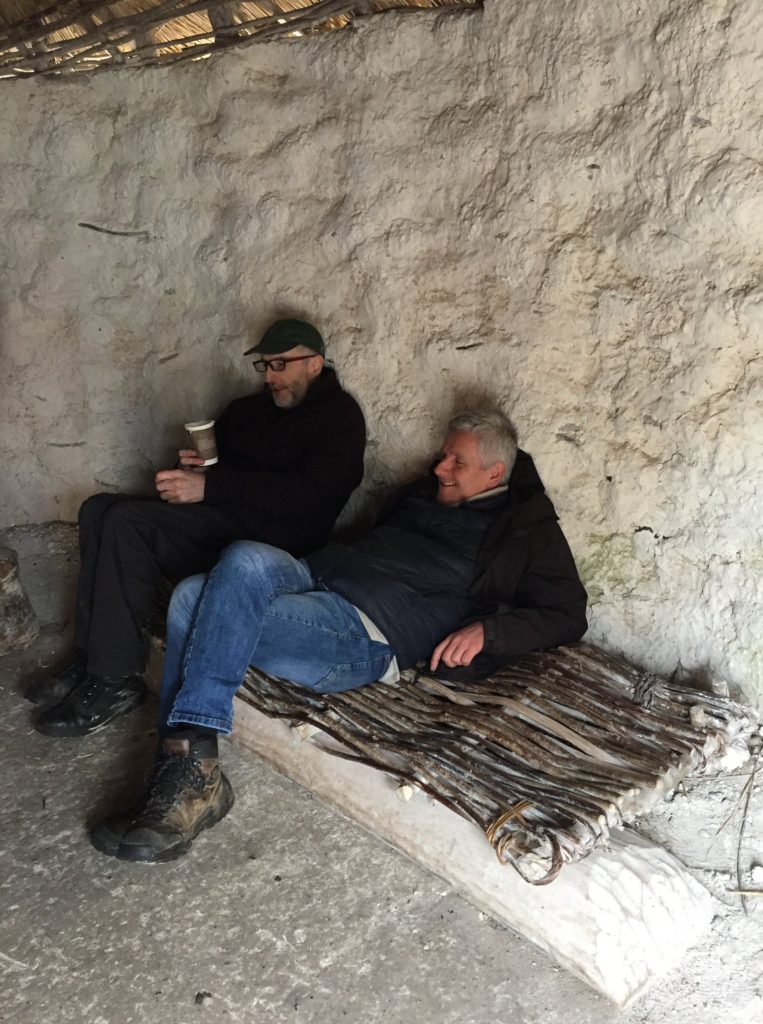
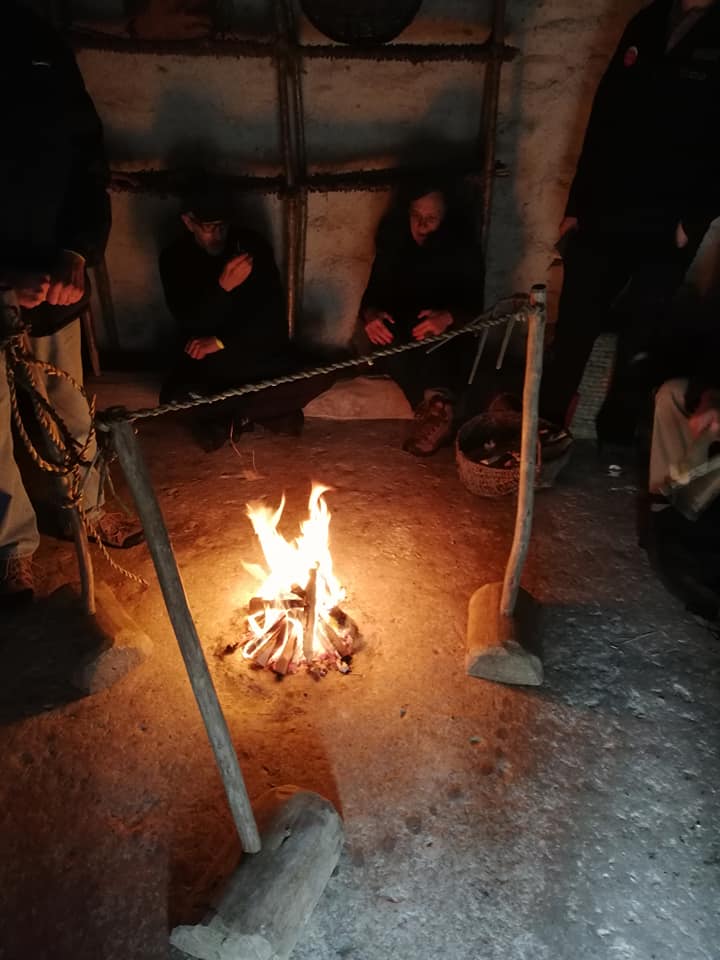
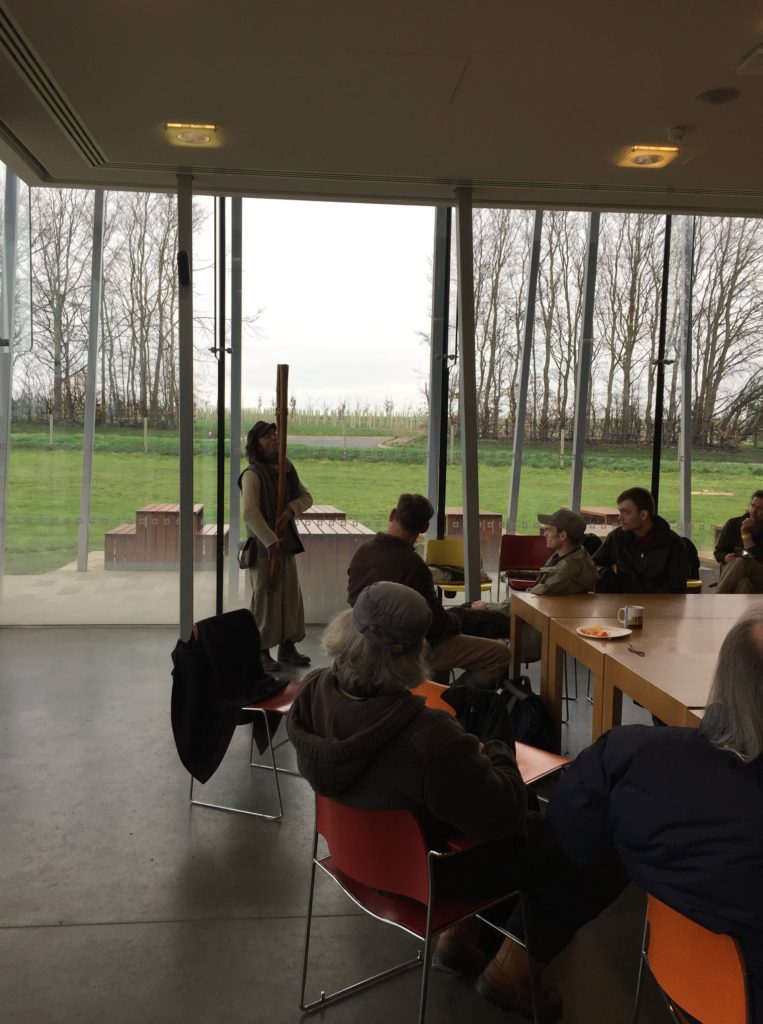
Thanks to Human Hengers, Prof Tim Darvill, Stonehenge staff and volunteers who lit the fires and smoothed the way, and Maxence des Oiseaux for making it such a special event.
HUMAN HENGE EVALUATION REPORT
Laura Drysdale, December 2018
This is an edited version of the report we provided to the Heritage Lottery Fund on completion of Human Henge
SUMMARY
Based at Stonehenge, Human Henge engaged people living in Wiltshire with mental health conditions in a creative exploration of the ancient landscape. The project began in September 2016 and ended in December 2018. A parallel research project led by Bournemouth University addressed the question of whether Human Henge was an effective way to improve people’s mental health and wellbeing. Evaluation by Willis Newson considered the project’s processes and behaviours as a contribution to its impact on participants mental health.
This evaluation and the research above concludes that Human Henge exceeded expectations in terms of its impact on participants, partners and the wider archive and mental health community. Overall it has been a successful project that we hope can be a model for similar projects to take place in other historic landscapes.
WHY HUMAN HENGE WAS CREATED
Human Henge grew out of a conviction, shared by the partners, that a connection with historic landscapes could play a real part in mental health recovery. Human Henge Change Minds was intended to have heritage, social and mental health outcomes, and as such amalgamated its partners’ concerns. English Heritage and the National Trust are heritage organisations with social purposes. Richmond Fellowship is a national mental health charity with a history of using community assets including historic landscapes for inclusion. Bournemouth University is an academic body with a strong social purpose and local connection. The Restoration Trust is a bridge organisation linking these outcomes, as it supports people with mental health issues to engage with heritage in order to reduce social exclusion and improve people’s mental health.
The project was largely funded by the Heritage Lottery Fund, but additional grants from English Heritage and Amesbury Area Board rooted it in Stonehenge and the local community.
Broadly, Human Henge followed the Activity Plan we submitted with our original application, with agreed amendments. Funding for Human Henge Avebury extended the programme of participation and research and in effect Human Henge at Stonehenge and Avebury became one project. However, this evaluation report focusses on Human Henge Stonehenge.
The first step on securing the grant was to set up a Project Board representing partners and key stakeholders, chaired by Dr Sara Lunt, a trustee of the Restoration Trust. Project Board meetings were well attended and often quite powerful experiences. There was robust debate about important issues, such as the wellbeing of participants the nature of research, ownership and rights over local heritage, and communications strategies. Most meetings were minuted by a Stonehenge staff member who attended for this purpose.
From the outset we did all we could to make Human Henge as safe as possible for everyone involved by policies and procedures which conformed to legislation and best practice. Data protection, communications and safeguarding were key issues where we set up policies in the preparation phase, and put them into practice in our enrolment forms, partnership agreements and employment contracts.
Human Henge aimed to improve the health and wellbeing of people who have mental health problems. It was not a mental health service. Although everyone had a duty of care to participants, to behave sensibly and kindly, and to record and share any concerns, Human Henge did not provide wider support. This was the responsibility of Richmond Fellowship. We maintained these boundaries in order that participants could enjoy Human Henge without feeling that they might be treated as patients or clients. It was also an important safety measure since mental health risk was assessed and managed by Richmond Fellowship.
LOCATIONS
TRAINING IN MENTAL HEALTH AND HERITAGE FOR STAFF AND VOLUNTEERS
In October 2016 we offered staff and volunteers mental health first aid training delivered by an accredited Mental Health First Aid trainer who was also a Richmond Fellowship staff member. 16 people attended, including board members, staff and volunteers.
The Coordinator is an archaeology and natural voice practitioner, so she brought heritage and creative skills to the project. Therefore, it was unnecessary for the Richmond Fellowship Locality Manager to acquire heritage skills, and he already had a deep interest in and knowledge of the natural world and creative writing.
In total 32 people were recruited and 23 people attended the programme as committed participants, i.e. they attended more than half the sessions. All these people consented to take part in the research component of the project.
Participants were enrolled through contact with their Richmond Fellowship support workers. Our recruitment leaflet was designed to be as clear and informative as possible, and also to alleviate anxiety about doing something entirely new. The enrolment form including consent for information sharing, photography and communications, as well as information about the participant and a wellbeing plan. Enrolment forms were held by both Richmond Fellowship and the Restoration Trust.
20 sessions were held, 10 for each group, weekly on Friday mornings (10.30 – 1.30). Transport, refreshments and materials were provided. There was no cost to participants. Each group followed a broadly similar plan:
Human Henge was intended to be a pilot project into the efficacy of using historic landscapes for mental health, so it was essential that we had a robust evaluation strand. This fell into three categories.
- Project staff – the Project Manager and Coordinator – collected data about attendance, events, visitor numbers and so on, for reporting outcomes at that level.
- Bournemouth University were commissioned to carry out research addressing the question: “Does a creative exploration of historic landscape achieve sustained, measurable mental health and wellbeing outcomes for people with mental health conditions?” Answering this was achieved through two parallel investigations. First, a study of available literature and published case studies was collated and published as a chapter in the volume A handbook of well-being edited by Kate Galvin (Darvill et al. 2018). Second was an evaluation of the impact of the Human Henge project on the mental well-being of its participants. This was published in two reports; firstly in June 2017, secondly in December 2018. An appendix to the final report will be produced when Human Henge Avebury participants complete a final 1-year post project questionnaire and focus group.
- Willis Newson were commissioned as the project’s ‘Critical Friend’/Evaluator, with a brief to: take an observer / critical friend role asking sometimes difficult questions; contextualise the project within wider work taking place across the Arts and Health sector / arts on referral / arts and health evaluation and research /good practice; signpost / make introductions to what is going on nationally; comment on how best to make the research findings accessible and implementable with the sector and amongst practitioners. Jane Willis’s report on Why and How does the Human Henge Project Support Participants Wellbeing was completed in July 2018.
Mental health and wellbeing outcomes
In brief, outcomes are summarised below.
Bournemouth University mental health research
It is difficult to answer the original research question “Does a creative exploration of historic landscape achieve sustained, measurable mental health and well-being outcomes for people with mental health conditions?” conclusively at this stage as data collection and analysis is still ongoing. Nevertheless, findings to date highlight that involvement in Human Henge had a positive impact upon participants’ mental health and well-being, and to some degree this was still apparent one year after involvement in the programme. However, caution is required because of the relatively small sample size and the limited extent to which it is can be said to represent the bigger picture. Accordingly, further data collection is needed before any claims about the generality of the findings can be made. It is proposed that a larger study, possibly with a control group, needs to be undertaken to explore the potential of this type of heritage programme for the health and well-being of people with mental health conditions.
Process Cycle
Willis Newson (Arts and Health Consultants) theorise that Human Henge is a cycle of transformative processes through: safety and trust; challenge and risk; achievement and confidence; connection.
- Safety and trust is built by secure partnerships and structures and good communication.
- Participants are overcome challenge and risk through expert facilitation.
- A sense of achievement is felt which leads to increased self-confidence and self-esteem
- Positive feedback to mutual sharing enhances the sense of connectedness.
- The enhanced sense of connection leads to an increased sense of safety and trust.
- New risk and challenge is introduced and the cycle continues.
- A deeper sense of achievement leads to increased self-esteem. Continued sharing leads to deeper connections. Deeper connection and bonding leads to an increased sense of safety.
New Economic Foundation’s Five Ways to Wellbeing.
- Take notice: the whole group has an intense sensory experience of the landscape.
- Be active: people get out and about, walking further and more confidently session by session.
- Connecting: people connect across deep time, with the place they live, and with each other.
- Learn: archaeology, creativity, nature, knowing a place. How to be with a group.
- Give: the group shares the experience. People help each other in practical ways.
Research methodology
Human Henge research by Bournemouth University comprised a mixed-methods approach summarized schematically below. The process was reviewed and approved prior to the start of the first programme in line with Bournemouth University Research Ethics Code of Practice.

It was important to capture both quantitative and qualitative data because the sample size was small and, whilst interesting, means that conclusions derived from the evaluation so far have limited generality. At the start of each delivery of the Human Henge programme the participants completed a baseline questionnaire capturing their thoughts and feelings towards the project. The Short Warwick Edinburgh Mental Wellbeing Scale (Tennant et al. 2007) was used to measure their mental wellbeing, supplemented by questions regarding their interests in history, heritage, and archaeology (see Table 2). The same questionnaire was repeated in the middle and at the end of each 10-week programme, and again for a final time in 2018 a year after the sessions finished. Quantitative data was analysed using descriptive and inferential statistics as well as content analysis, qualitative data from the evaluation was analysed thematically using the Braun and Clarke (2006) process of thematic analysis.
MILESTONES TIMELINE
2016
Sept
Grant received, Project Board Meeting 1 at Bournemouth University
Project manager, coordinator, consultants, designer and volunteers appointed.
Communications policy agreed
Research ethics approval received from Bournemouth University
Enrolment leaflet circulated via Richmond Fellowship
Press release approved.
Group 1 Session plan agreed
Oct
Mental Health Fist Aid training for staff, consultants and volunteers
Human Henge launch event at Stonehenge
Website, social media and publicity material launched
Group 1 participants recruited
Group 1 sessions begin
Group 1 mental health research begins
Nov/Dec
Website and publicity material launched
Group 1 reflective practice research begins
Project Board Meeting 2 at Amesbury Communitea Café
Group 1 sessions culminate in Winter Solstice celebration
Group 2 participants recruited
2017
Jan/Feb
Group 1 end point research
Group 2 mental health research begins
Group 2 sessions underway
March/April
Human Henge introductory session for National Trust staff and volunteers
Group 2 sessions end
Group 2 Human of Stonehenge private Facebook group formed
Radio 4 Open Country programme Stonehenge and Mental Health broadcast
Project Board Meeting 3 at Salisbury Museum
May/June/July/August
Exhibition at Amesbury Library
Stakeholder consultation meeting at Wiltshire Museum
Presentation at Culture Health and Wellbeing International Conference
Exhibition and workshop at Festival of Archaeology Salisbury Museum
Human Henge picnic at King Barrow Ridge
Exhibition at Stonehenge Visitor Centre
Sept/Oct
Project Board Meeting 4 at Avebury
Heritage Open Day walk at Stonehenge
University of the 3rd Age lecture at Bournemouth University
Exhibition at Salisbury Library, Melksham Library, Chippenham Library
Nov/Dec
Funding awarded for Human Henge Avebury
Follow-up research with Group 1 participants
Theoretic Archaeology Group conference session on Archaeology, Heritage and Wellbeing and Mental Health
2018
Jan/Feb
Human Henge Avebury sessions underway
March/April
Project Board Meeting 4 at Avebury
Human Henge Avebury sessions end
Workshop at West of England Learning Symposium
Presentation at Trowbridge Service Users Group
World Heritage Day walk at Avebury
Follow up research with Group 2 participants
Historic Landscapes and Mental Wellbeing conference at Bournemouth University
Exhibition at Bournemouth University, Avebury, Devizes Library, Wiltshire Museum
June/July/August
Heritage and Welling workshop at Canterbury University
Human Henge follow-up event at Ancient Technology Centre
Sept/Oct
National Women’s Register presentation at Salisbury
Nov/Dec
Human Henge follow-up event at Wiltshire Museum
REVIEW
Summary of what worked
Human Henge has amply met all the Restoration Trust’s criteria for success, which are informed by and embodied in the project.
- Participants have problems with their mental health. Human Henge participants had complex mental health needs.
- Participants are involved in management. One participant became a member of the Change Human Henge Project Board, 8 contributed to a Sharing Event and 4 attended a Restoration Trust Participants Council. The Project Board included a Patient Public Involvement member.
- Partnership with heritage and health organisations. The partnership between the Restoration Trust (RT), English Heritage, Richmond Fellowship and Bournemouth was confirmed in a signed partnership agreement which stated that the partners would deliver the project according to our application to Heritage Lottery Fund. All partners are members of the Project Board. Contributing organisations, including the National Trust, Avon and Somerset NHS Partnership Trust are represented on the Project Board.
- Groupwork is the core. All sessions were group sessions and informed by relevant theory and practice. They were based on the view that lasting change can occur within a carefully conducted group.
- Safe framework and practice. The partners’ policies and practices meet the required standards, and due diligence was applied when forming the partnership. Staff and volunteers worked to relevant professional standards and, if it was required for their role, had external validation of their suitability to work with vulnerable people by showing evidence that they have Enhanced Disclosure and Barring Service Certificate (DBS).
- Proper measurement of impact and outcomes. Research by Bournemouth University and Willis Newson. Ethical approval by Bournemouth University Ethics Committee. Participants were recruited as Richmond Fellowship clients rather than NHS patients so research did not need NHS ethics approval
- Sustained and regular involvement. 10 weekly sessions. Three workshop sessions after the project ended. Ongoing informal connections between people and through the Humans of Stonehenge private facebook group. Richmond Fellowship ongoing history projects, including visits to Wiltshire Museum, and a series of workshops at Salisbury Cathedral.
- Privileged access to real cultural assets and expertise. Assets: Exclusive use of Stonehenge Education Room, special access to Neolithic Huts with Stonehenge volunteer input, special access to Stone Circle, special access to National Trust Cottages for King Barrow Ridge. Expertise: sessions with Professor Tim Darvill, Dr Sara Lunt, Katherine Snell, Yvette Staelens, Mark Vyvyan Penney, Briony Clifton. Museum visits included Wiltshire Museum tour with the Director, Salisbury Museum (Festival of Archaeology).
- Encouragement to be creative. Music, pottery, creative writing, photography and encouragement to tell stories and share language and song.
- Learning for staff and volunteers. Health learning: Mental Health First Aid. Heritage learning: Prehistory and the Stonehenge landscape; collections, Neolithic pottery and firing; bread making. Research learning: Staff and volunteer reflective practice focus group. Good practice learning: Project Manager supervision by a Group Analyst, Coordinator supervision by the Project Manager. Professional learning: Staff and volunteers attended relevant professional meetings. Learning from participants: experiences of nature, photography, music, spirituality, history, archaeology, managing mental health, practical financial advice and friendship.
- Progression for participants. Volunteering and participation opportunities offered by all partners. Participation opportunities taken up at conferences, workshops, events and media.
Resources. We needed to allow more time and money for project management and digital engagement. As a small organisation whose backroom activities are funded through projects, we need more unrestricted funding to maximize the impact of this high-profile project. Our Chair devoted more pro-bono time to the project than she had anticipate
The demands of the site. The immense benefit of running a project at Stonehenge in terms of public and professional attention was matched by the need for attentive management of the delicate balances required in dealing with conflicting interests at a contested site. We were not always successful in negotiating these tricky waters, and indeed they were not really our business. However they sometimes impacted on the project, or rather they demanded more time than we had allocated for project management.
Partnership. The Restoration Trust is a small organisation managing a complex partnership of much bigger organisations, some of whom have competing interests.
Cuts to services and contracts. The Richmond Fellowship’s outreach and inclusion contracts have been reduced since the project began, and this has made it more difficult for the Locality Manager to provide staff resources to support people to attend follow-on activities.
Mental health discrimination. There is a level of unconscious discrimination against people with serious mental health problems which is manifest by partner organisations and professionals in unexpected ways. Excessive anxiety about what people might do on site, or how to cope if they became unwell reflect wider societal attitudes. Participants were sometimes surprised and disconcerted by views expressed by volunteers, staff, students and the general public.
Ending the programme. The ending of the programme was experienced as a considerable loss, as it was rather abrupt. As a result we gained funding to run three follow-on sessions, which have been successful gatherings of Human Hengers at local heritage venues (Ancient Technology Centre, Wiltshire Museum, Stonehenge Stone Circle in March 2019).
CONCLUSION
Overall Human Henge has been a successful project, with benefits for participants, partners, stakeholders and the local and professional community that went beyond our expectations. It justified our original supposition that walking with intent in ancient landscapes has the potential to support the recovery of people with complex mental health needs, although research outcomes are not conclusive. However the enthusiasm with which Human Henge was received by both heritage and health professionals shows that imaginative use of heritage landscapes can make a profound difference to individuals, and we hope also to mental health and heritage policy and practice at local and national levels.
We are very grateful to our partners, staff, volunteers, researchers, board members, local media and national media, and those who visited Human Henge exhibitions and events. We thank the Heritage Lottery Fund for their grant, which enabled the project to take place. Our foremost thanks go to all the Human Hengers, who through their courage and commitment turned the idea of a creative exploration of historic landscapes into a powerful experience for everyone involved.
A Telescopic View of the Moon on Friday 21 February

A telescopic view of the moon by Adam Hinton
This exquisite image of the moon was taken by Adam Hinton during the Human Henge night walk along West Kennet Avenue on Friday 21st February.
Drawings of Avebury’s ancient landscape
Some beautiful and evocative drawings of places in Avebury’s ancient landscape that have been part of the Human Henge experience there. With thanks to artist Donna Songhurst.

Avebury by D. Songhurst

Lockeridge Dene by D. Songhurst

Swallowhead Springs by D. Songhurst

West Kennet Long Barrow by D. Songhurst

Windmill Hill by D. Songhurst
Telescope view, Avebury night walk 21 Feb 2018
Avebury Session 6:West Kennet Avenue, night walk – 21 Feb 2018
Photos and text by Shane Faulkner
This week’s session was quite a unique experience indeed, as we explored a nocturnal Avebury…
On arriving at Avebury, it was already cold and dark. We assembled in the public village carpark, especially eager for this week’s offerings. I personally, have never been around the stones at night, so I was glad of the opportunity and was looking forward to the experience. Above me, framed by eerie silhouetted branches, grey and misty clouds pushed through the cold night sky occasionally giving up an ephemeral, mystical treasure, the glowing crescent moon. We got clad in our cold weather apparel, had a brief catch up and chat before setting off. People appeared energised by the exciting and somewhat unknown adventure that lay ahead. With torches, head lights and phones at the ready, we made our way out towards the stones.
We traversed the south west sector of the henge, crossed the main road and entered the south east sector. Mist was starting to creep in all around us and the cold air was trying to bite. All of a sudden, out of the darkness ahead of me, appeared two huge grey figures. These figures stood sentry to a pathway yet trodden. Between them lay an invisible gateway, a portal, suggesting both start and ending. Slowly, more grey figures appeared to my side, flanking me as I preceded through the night.

Each figure grabbed my attention, their sense of presence was extremely powerful. As I approached the ‘gateway’, the huge grey figures loomed above and either side of me. I couldn’t help but feel honoured yet humbly uninvited as I committed to this path. The two huge entrance stones (no.s 1 & 98 – pictures below) mark the Southern entrance of the henge and the start of the ‘avenue’. Stone 98 is known as the ‘Devil’s Chair’. As the pathway winds and snakes down the edge of the hill you are greeted either side by animate forms. We were now all following the avenue of stones.


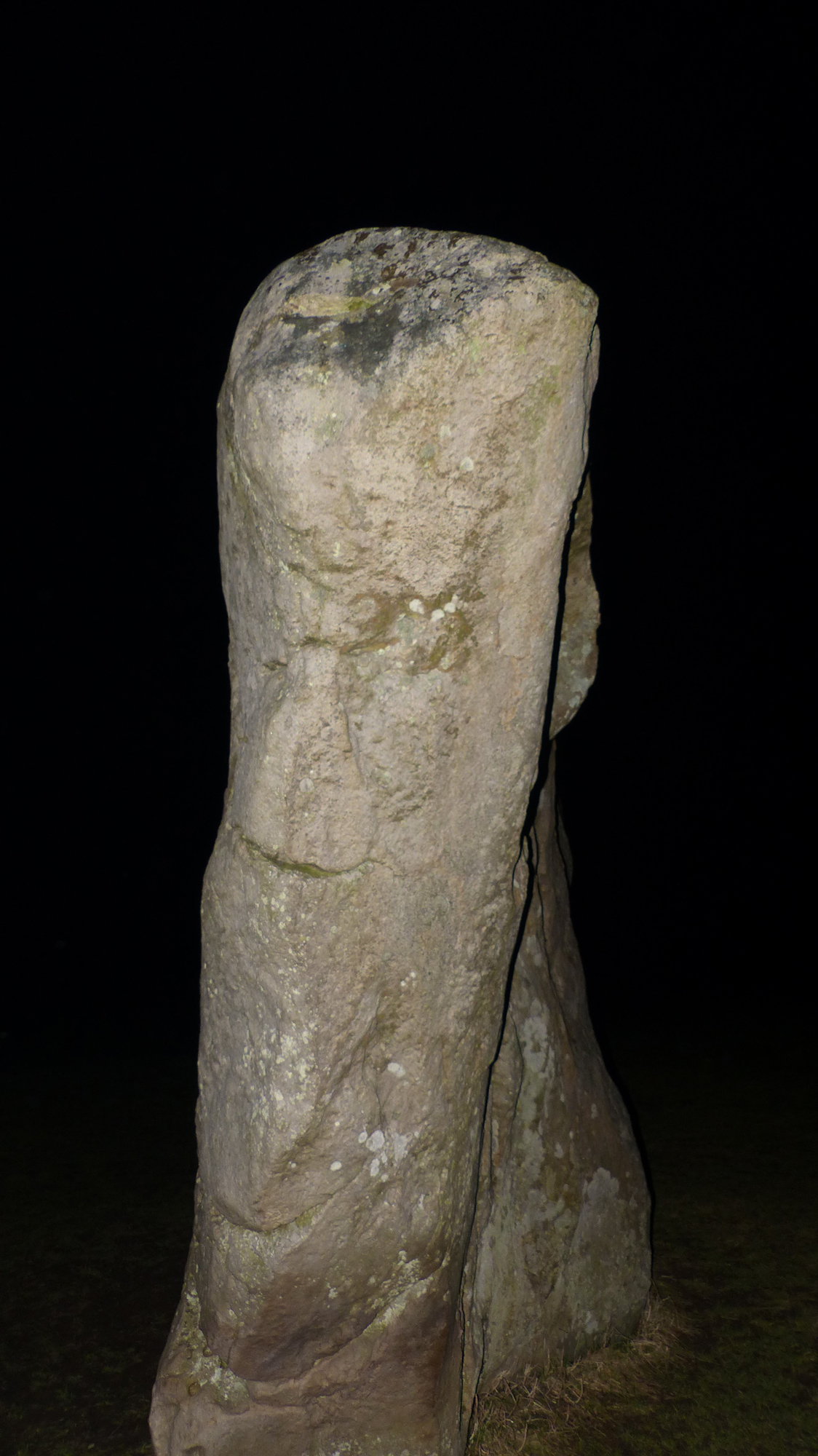
We stopped with Prof Tim Darvill at the top of West Kennet Avenue to talk about what the avenue might have represented for the early peoples. We tried to understand it through their eyes. We thought about its practical use and the possible symbolic meanings. What would the peoples have seen as they followed its winding path? Whether coming from the Sanctuary area or from the henge itself, there are many different and hidden perspectives as one travels its flowing length. Was the avenue used by many or just a select few? After contemplating these questions we preceded onwards.
More stones manifested out of the darkness, some of which were quite small; being the modern markers for where a stone would once have stood. One theory proposed by Keiller & Piggott is that the avenue & henge stones can be separated into male and female anatomical forms. These stones are labelled (Type a) and (Type b) respectively. The typical comparative example being stones 13a & 13b as seen below.

 To my side, Waden Hill rose gently off to the right, hiding the western horizon. I stopped to touch one of the standing stones. Were the stones trying to speak to me? I tried to communicate with these sentient figures but I am as yet not fluent in the language.
To my side, Waden Hill rose gently off to the right, hiding the western horizon. I stopped to touch one of the standing stones. Were the stones trying to speak to me? I tried to communicate with these sentient figures but I am as yet not fluent in the language.

On reaching the end of the restored section of the avenue we talked about the connection between the Neolithic peoples and their monuments to the cosmos.
The Neolithic people had already built up a considerable astronomical knowledge base from earlier times. They were very familiar with the heavens, the sun, moon and stars. These Neolithic people had none of the distractions and visual entertainment of today. The day and night skies were their windows, their TV screens, their pages of a book and they would have spent much time observing them. They would have witnessed the movements of the celestial bodies, of the stars and the galactic plane. They also would have witnessed strange repeating occurrences such as eclipses. It was an ever moving story, of life and death, rebirth, symbolism, spirituality, the celestial sphere was their very guidance. The peoples would have planted and harvested by these cycles. They would have planned daily events and ceremonial activities in tune with the heavens. The celestial cycles help track the passage of time. Looking within Archaeoastronomy, the night sky inspired the building of the monuments. The monuments may have mirrored the night sky, “as above, so below”. The peoples of this time were looking for their identity within the great cosmos.
We gathered around an image of the impressive Bronze Age artefact, the Sky Disc of Nebra (see image below). The disc is understood to represent an astronomical clock, bringing together both solar and lunar calendars. The gold leafed highlights represent the sun, moon, stars (Pleiades) and an arc. The arc is interpreted by some as a sun boat (the sun would travel the waters of the underworld by boat every night re-emerging from the waters at dawn). We compared it to a modern planisphere that Danny was discussing.
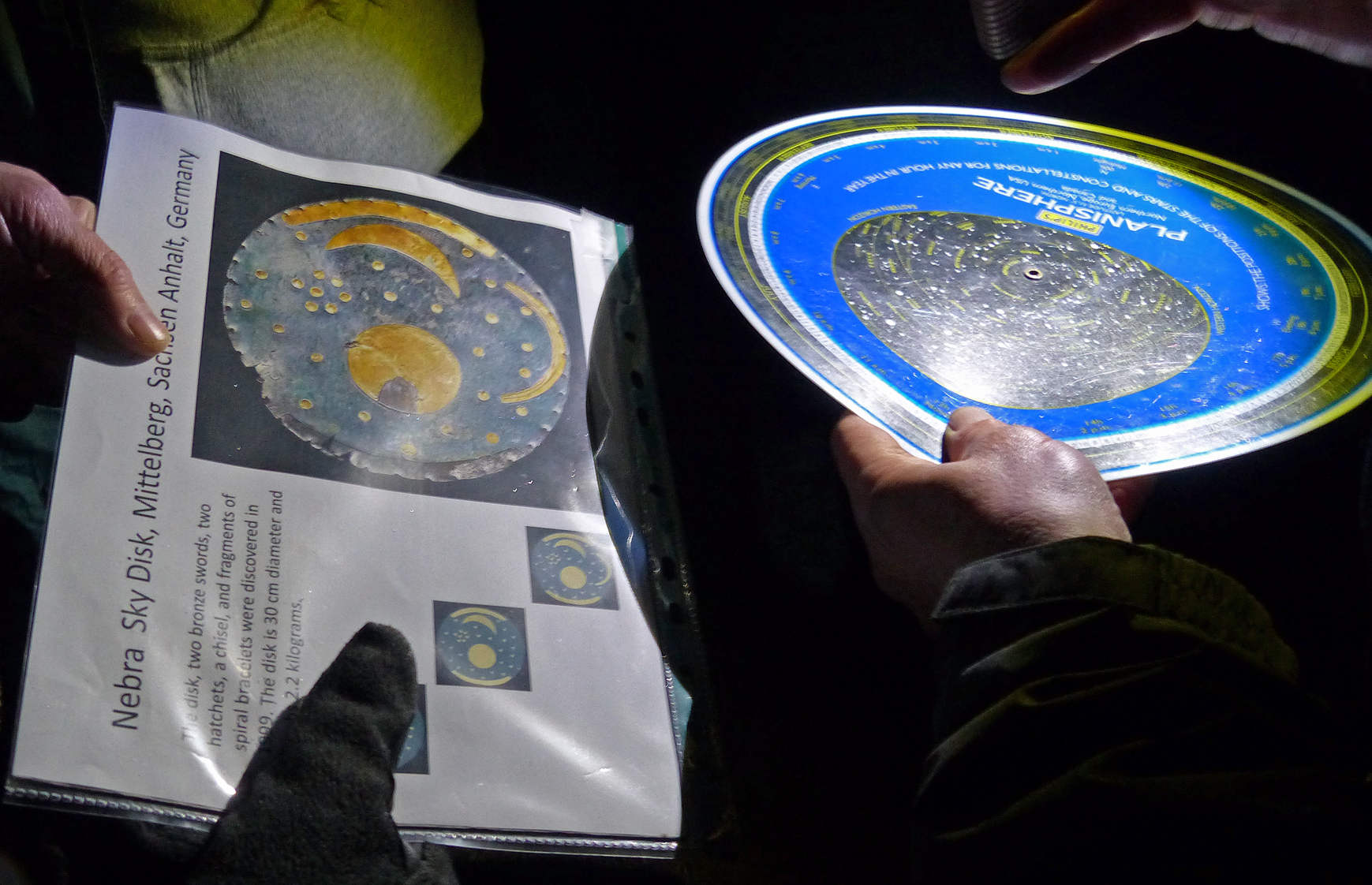 Luckily the cloud of earlier started to clear and the moon and stars revealed themselves. Another group member and I had brought telescopes, so we set these up so others could have a closer look at the night sky. We looked at the crescent moon and the shining Pleiades to peoples awe’s and wows. We also looked at the stars of Orion and the Orion nebula, the pole star Sirius, the constellations Gemini, Auriga, Taurus and also Ursa Major (aka the ‘plough’).
Luckily the cloud of earlier started to clear and the moon and stars revealed themselves. Another group member and I had brought telescopes, so we set these up so others could have a closer look at the night sky. We looked at the crescent moon and the shining Pleiades to peoples awe’s and wows. We also looked at the stars of Orion and the Orion nebula, the pole star Sirius, the constellations Gemini, Auriga, Taurus and also Ursa Major (aka the ‘plough’).

We ended the session walking back along the avenue toward the henge. Another person and I walked alone at the back. Being alone in the avenue, surrounded by grey figures and misty fields, shrouded by the starry night sky, the atmosphere felt heavy. I was being transported back in time to a place of unfamiliarity and yet, at the same time, feeling strangely familiar?
I looked up to the stars, the sky and the earth connected as one. I was being drawn in, into the briefest of glimpses of a cosmic plan. As I left the avenue behind, mist hung over the ground, the moon shone, stars twinkled, and all was still.
Next Week: Avebury Landscape.
BBC Wiltshire radio piece
Here’s Rhiannon Fitzgerald of BBC Wiltshire with a beautiful piece about Human Henge, recorded during our 8th session at King Barrows Ridge. Broadcast today on the Breakfast Show.
Heritage and Historic Landscapes are good for you!
Here’s our latest Press Release, created by Jessica Trethowan, Stonehenge PR Manager.
Heritage and Historic Landscapes are good for you!
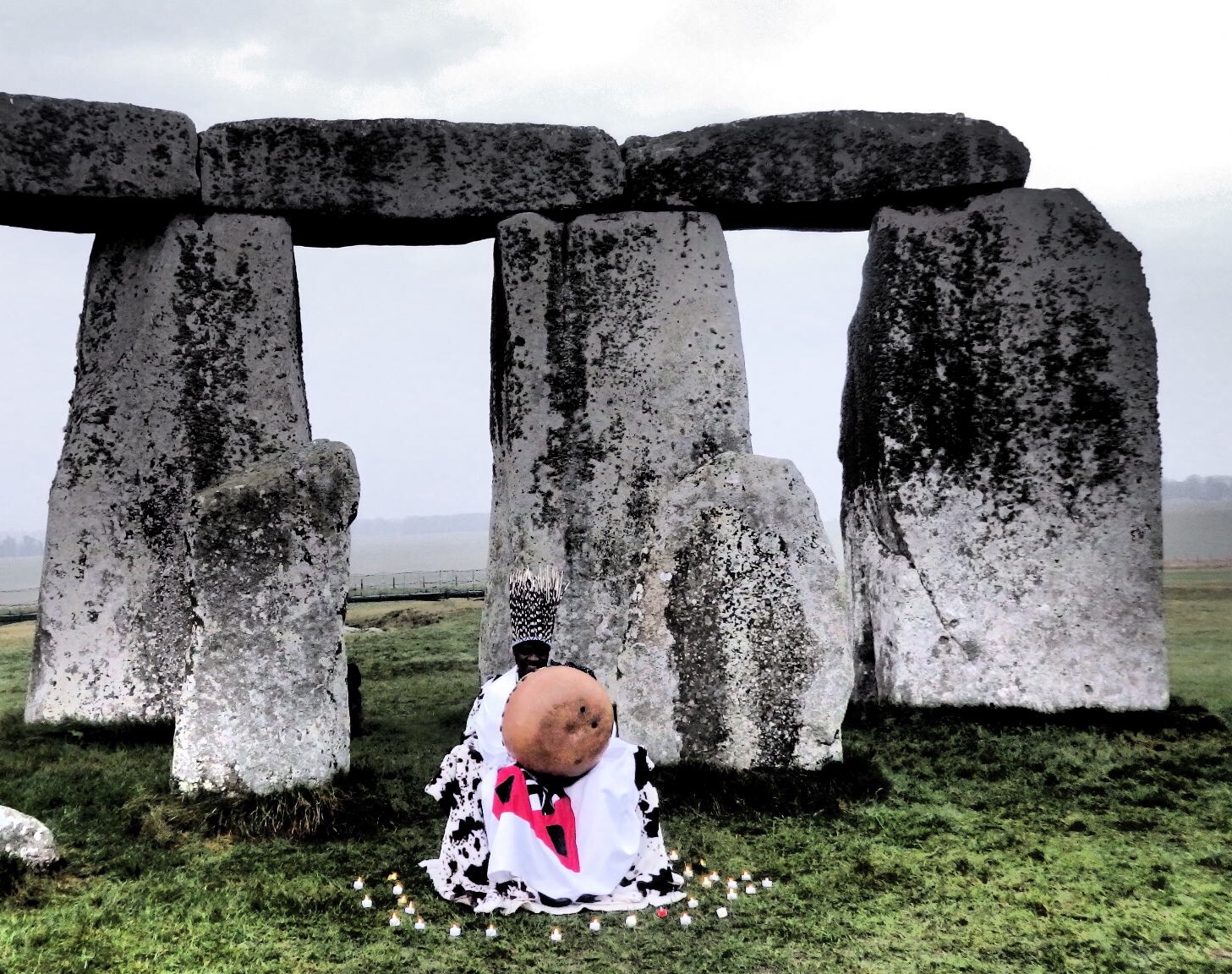
Photo by Yvette Staelens
“Human Henge: Historic landscapes and mental health at Stonehenge”
- Ground-breaking project about archaeology, mental health and creativity
- Cultural therapy through a number of journeys across the Stonehenge World Heritage Site into the world-famous stone circle.
Human Henge is a collaborative project run by the Restoration Trust in partnership with Richmond Fellowship, English Heritage and Bournemouth University with support from the National Trust and Avon and Wiltshire Mental Health Partnership NHS Trust.
The project draws on ideas that Stonehenge was once a place of healing and explores the relationship between people, place and the past. It examines whether a creative exploration of historic landscapes can help people with mental health conditions.
Through a programme of participant-led activities, 32 local people living with mental health problems and on low incomes, come together for fun, therapeutic adventures, with experts, carers and support workers in this remarkable and inspiring ancient landscape.
Laura Drysdale, Director of the Restoration Trust says, “We hope that Human Henge will get people doing things they’ve never contemplated before, from star spotting on the cursus, to chanting poetry inside the stone circle, to presenting at conferences, curating an exhibition or publishing a book. That’s the whole Human Henge journey.”
Participant Andria Walton says, “Human Henge is a personal journey of healing for me. I live with emotional health issues, and I feel very comfortable and accepted with this group. It’s meaningful to learn about our ancient cultures, it’s exhilarating being in the open air, it blows away the cobwebs. It’s rejuvenating and revitalising.”
The group is accompanied by curators and artists, archaeologist Professor Tim Darvill, and musician and creative facilitator Yvette Staelens, as they explore the monuments, features and layers of meaning in the Stonehenge landscape, enabled through the participation of English Heritage and the National Trust. Each series of journeys end with a ceremony inside the Stone Circle, collaborating with musician Chartwell Dutiro at Winter Solstice or Spring Equinox. The final activity is devised by the participants in response to their individual and shared experiences on their journey.
Professor Tim Darvill of Bournemouth University said “Human Henge has really opened up new ways of looking at the Stonehenge Landscape and thinking about the way people might have used it and experienced it in the past. By spending time at a selection of the sites around Stonehenge it becomes possible to think about the landscape, the skyscape, and the monuments themselves. We can look at how their form structured the way people approached them and moved around them. Materials such as stone and clay come to life in your hands as you think about their uses and meanings, while sounds help the imagination travel back in time to the world of the early farmers.”
Speaking of one of their journeys in the landscape, one participant said “It was a day of connections, connecting to new people, a new landscape and maybe in some small way our ancestors.”
Another added, “This week was reflective. It was about connecting on a personal level with the landscape by listening to the birds and the wind, feeling the cold, sitting in the grass and being surrounded by these amazing burial monuments.”
“The experience felt completely natural and restorative. Perhaps we were connecting to something beyond us. The stones towering over you remind you of your smallness in this big world, and yet bring you together as part of a wider history with our ancestors.”
Martin Allfrey, Senior Curator of Collections, English Heritage said “We all know that visiting historic sites and engaging with artefacts from the past can be inspiring and fun but we’ve never tried to measure the benefits that historic places can provide for people suffering from mental health issues. We are really pleased that Stonehenge is the focus for this groundbreaking project, which brings together expert researchers from Bournemouth University and local people in Wiltshire. We hope that not only will the project add to the quality of life of those taking part but we also want to share the results widely, promoting a much greater understanding of the health and well-being benefits of engaging with historic places”.
The Human Henge project runs until June 2018. Findings and further questions will be explored and shared through activities, focus groups, exhibitions and conferences.
Notes to editors
- Human Henge enables 32 local people living on low income with mental health problems plus carers and volunteers to experience Stonehenge with expert guidance. They create an epic poem and ceremony that affirms the abiding connection between people, place and the past.
- Human Henge engages disadvantaged people living in Wiltshire in a therapeutic sensory experience of the World Heritage Site.
- Human Henge is a partnership with English Heritage, Richmond Fellowship and Bournemouth University supported by the National Trust and Avon and Wiltshire Mental Health Partnership NHS Trust. The project is also part funded by Wiltshire Council Amesbury Area Board and English Heritage.
- About the Restoration Trust: We help people with mental health problems engage with art, culture and heritage; we call it culture therapy. Our life-enhancing projects are partnershipsbetween arts and heritage organisations and organisations that support people with mental health conditions. We research the evidence of what works for wellbeing, and we spread the word about what we do. http://www.restorationtrust.org.uk
- Exhibitions at Amesbury Library, Salisbury Museum Festival of Archaeology and Bournemouth University, and proposed presentations at Theoretical Archaeology Group conference 2017, Culture, Health and Wellbeing international conference 2017 and an international Archaeology and Wellbeing conference 2018 share learning with the public and professionals.
- About the Heritage Lottery Fund: From the archaeology under our feet to the historic parks and buildings we love, from precious memories and collections to rare wildlife, we use National Lottery players’ money to help people across the UK explore, enjoy and protect the heritage they care about. hlf.org.uk.
- For further information, images and interviews, please contact
Laura Drysdale, Director of The Restoration Trust on mobile 07740 844883 and email laura@restorationtrust.org.uk

